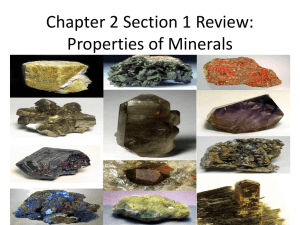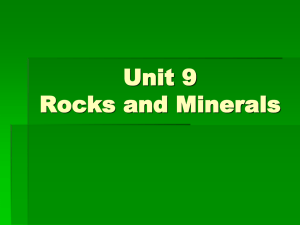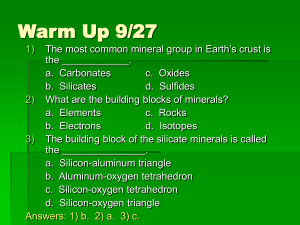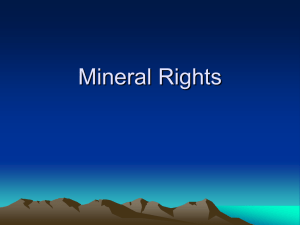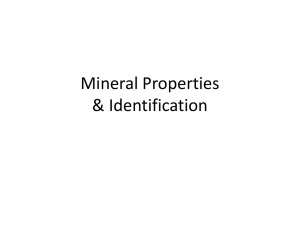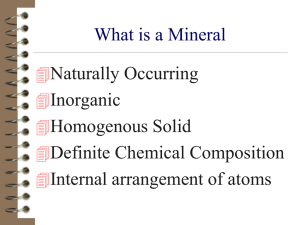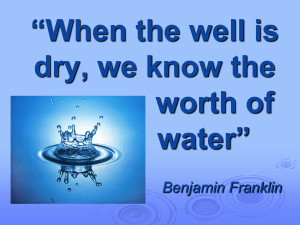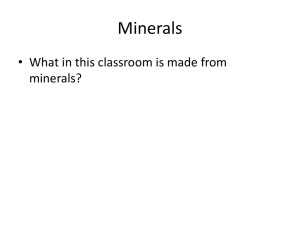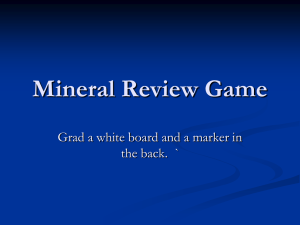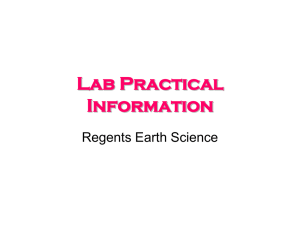Mineral Worksheet 1a Review
advertisement
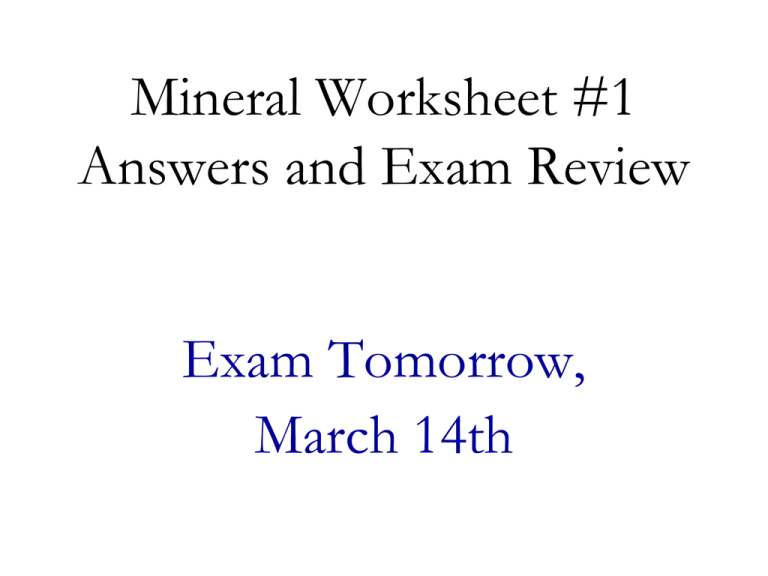
Mineral Worksheet #1 Answers and Exam Review Exam Tomorrow, March 14th m j The way a mineral reflects or “reacts” to light. a. Native Element A mineral’s resistance to being scratched. b. Cubic Magnetic c. Hexagonal 4. o k This crystal system has three axes that all intersect at oblique angles. d. Effervesces 5. l The color of a mineral’s powder when rubbed across an unglazed porcelain plate. e. Monoclinic 6. g When minerals don’t break along cleavage lines. f. Crystalline Solid 7. i This crystal system has three axes of different length that intersect at 90 degree angles. g. Fracture 8. a When a mineral exists as a single element. h. Color 9. b This crystal system has 3 axes of equal length that intersect at 90 degree angles. i. Orthorhombic 10 c This crystal system has three horizontal axes that are the same length and intersect at 60 degree angles, and one longer vertical axis. j. Hardness This crystal system has three axes, two of which intersect at right angles and one that intersects the other two a an oblique angle. k. Triclinic This is when a mineral reacts with a weak acid to produce bubbles. l. Streak 13 d p This is the plane or planes in which a mineral tends to split. m. Luster 14 n Glows when a black light is shined on a mineral n. Fluorescence 15 h The most misleading property of a mineral, in terms of determining its identity o. Magnetic 16 f This is something that has its atoms arranged in a repeating pattern. p. Cleavage 1. 2. 3. 11 12 e 17. What are four conditions that define a mineral? • naturally occurring • abiotic • repeating pattern of atoms (crystal) • definite chemical composition 18. What is 1 reason that color isn’t a good method of identifying minerals? • more than one mineral can have a particular color • a mineral can exist as more than one color • some minerals change color over time 19. What are the two types of luster? • metallic • non-metallic 20. List as many of the acceptable adjectives for luster as you can. Next to each adjective, write a description and give one mineral that can be used as an example of that type of luster. • waxy • like a candle • rose quartz • vitreous • glassy • crystal quartz • dull • well, dull • red hematite • earthy • no luster • limonite • adamantine • most brilliant • diamond • pearly • like a pearl • muscovite • silky • like a silk shirt • malachite • greasy • an oily sheen • talc • resinous • syrupy-shiny • sulfur 21. List as many of the acceptable adjectives for fracture as you can. Next to each, write a description and give one mineral that can be used as an example of that type of fracture. • • • • • • • conchoidal even fibrous splintery uneven brittle sectile • • • • • • • like sea-shell smooth stringy needles less smooth crumbly can be carved • • • • • • • rose quartz kaolinite gypsum malachite magnetite limonite sulfur 22. For properties of luster and fracture, we are restricted in the words we can use. Explain why do we use a reduced vocabulary? • a reduced vocabulary increases the objectivity and improves accuracy. 23. There are a few minerals that you have worked with over the past week that are very distinctive and should be able to be identified by sight only. Name one mineral that you can (or should be able to) identify simply by looking at it. Explain what is so distinctive about this mineral, that allows you (or should) to do this. 24. There are two ways to describe cleavage, describe what they are and how they are used. • quality of the cleavage (how easily it is seen or detected) • the planes (& angles) of the cleavage. 25. Name one mineral that has an easy to see cleavage. 26. List three tests that you could perform on a mineral to help identify it. - hardness (Moh’s hardness scale) - streaking (to see the color) - weak acid test (effervescence) - black light (fluorescence) 27. Of all the tests that can be performed on a mineral to help identify it, which one is the most useful? Why? 28. Write the defining mineral for each level of the Moh’s Hardness Scale in the table below. Moh’s Hardness Number Defining Mineral 1 2 Talc Gypsum Calcite Fluorite Apatite Orthoclase Feldspar Quartz Topaz Corundum Diamond 3 4 5 6 7 8 9 10 29. List the tools that are used to determine hardness. Write the Moh’s hardness number next to each tool. Tool Moh’s Hardness Number Fingernail 2.5 4.5 5.5 5-8 Steel Nail Glass Plate Streak Plate 30. Why does the hardness of some minerals have such a large range? - minerals naturally occurring and can vary in hardness because of natural variation 31. List six of the eight most common elements in the earth’s crust? - oxygen (O) - silicon (Si) - aluminum (Al) - iron (Fe) - calcium (Ca) - sodium (Na) - potassium (K) - magnesium (Mg) 32. Define the word abiotic? Natural, but not from or of any biological or living organism. 33. What is one way that minerals form? - hot magma or lava cools - water containing minerals evaporates - sustained heat and pressure change one mineral into another 34. Why do we study minerals? - minerals are the starting point for understanding ALL geologic phenomena 35. You have studied minerals for approximately two weeks. What is a rock and how is it different than a mineral? Rocks are made of an aggregate (gathering or mixture bound into one object) of minerals.
